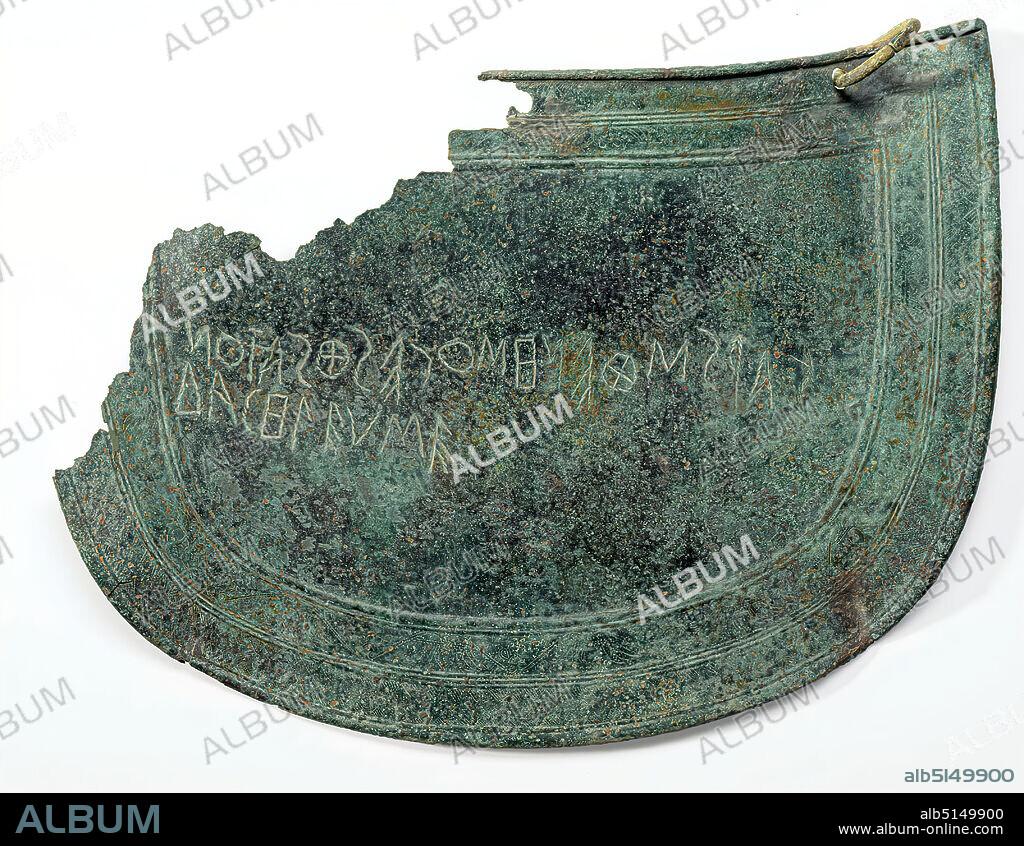alb5149900
Mitre with inscription, bronze, chased, engraved, punched, bronze, total: height: 17 cm; width: 23 cm, inscription: Front: | , protective clothing, armor (warfare/military), weapons (warfare/military), ritual objects and accessories, votive offerings, burial objects, ornaments, lotus ornament, early archaic, Greek antiquity, The mitre is an arch-shaped protective plate for the abdomen, whose convex forged rounding corresponds to the shape of the human abdomen. They seem to be a Cretan peculiarity. Suspended from rings, miters were probably attached to a belt worn under the protruding edge of the bell armour. The edges of miters are usually rolled around a reinforcing wire like the breast and back armour. On some, a figurative representation occupies the entire segment surrounded by the parallel bars. Here, however, there is a two-line inscription in the center. This is one of the oldest Greek inscriptions known. In Boustrophedon ('how the ox ploughs') the following text is engraved in the opposite direction: 'Karisthenes, the son of Peithias carried him away'. The two flat edge strips formed by the border strips contain finely carved and punched ornaments: a lotus palmette tendril and a row of teeth.

|
Añadir a otro lightbox |
|
Añadir a otro lightbox |



¿Ya tienes cuenta? Iniciar sesión
¿No tienes cuenta? Regístrate
Compra esta imagen

Descripción:
Ver traducción automática
Mitre with inscription, bronze, chased, engraved, punched, bronze, total: height: 17 cm; width: 23 cm, inscription: Front: | , protective clothing, armor (warfare/military), weapons (warfare/military), ritual objects and accessories, votive offerings, burial objects, ornaments, lotus ornament, early archaic, Greek antiquity, The mitre is an arch-shaped protective plate for the abdomen, whose convex forged rounding corresponds to the shape of the human abdomen. They seem to be a Cretan peculiarity. Suspended from rings, miters were probably attached to a belt worn under the protruding edge of the bell armour. The edges of miters are usually rolled around a reinforcing wire like the breast and back armour. On some, a figurative representation occupies the entire segment surrounded by the parallel bars. Here, however, there is a two-line inscription in the center. This is one of the oldest Greek inscriptions known. In Boustrophedon ('how the ox ploughs') the following text is engraved in the opposite direction: 'Karisthenes, the son of Peithias carried him away'. The two flat edge strips formed by the border strips contain finely carved and punched ornaments: a lotus palmette tendril and a row of teeth.
Crédito:
Album / quintlox
Autorizaciones:
Modelo: No - Propiedad: No
¿Preguntas relacionadas con los derechos?
¿Preguntas relacionadas con los derechos?
Tamaño imagen:
4320 x 3344 px | 41.3 MB
Tamaño impresión:
36.6 x 28.3 cm | 14.4 x 11.1 in (300 dpi)
Palabras clave:
ACCESORIO • ADJUNTA • ADORNO • ANILLOS • ARMA • ARMADURA • ARMAS • BARRAS PARALELAS • BARRIGA • BOUSTROPHEDON • BRONCE • BRONZE • CONFLICTO BELICO • DECORACION • DECORATIVO • DENTADURA • DIENTE • DIENTES • DIENTES, LOS • ESTOMAGO • EXVOTOS • FILA • FORMA • FRONTAL • GRABADO • GUERRA • HIJO • HILERA • INSCRIPCION • MILITARES • MUELA • OBRA DE BRONCE • ORNAMENTACIÓN • ORNAMENTO • PECHO • ROPA DE PROTECCIÓN • SHAPE • WAR • WEAPON
 Pinterest
Pinterest Twitter
Twitter Facebook
Facebook Copiar enlace
Copiar enlace Email
Email
